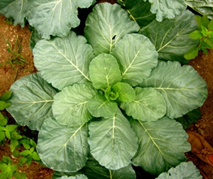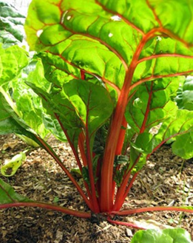Three dark, leafy greens that you can add to your menu today for nutritional benefits
Dark leafy greens are being promoted for their many nutritional benefits. What are the different kinds of dark leafy greens that you can find at your farmers market or grocery store?
The USDA’s MyPlate recommends half your plate be filled with vegetables and fruits. Dark green leafy vegetables are very rich in vitamins and vital nutrients. But you may not understand the difference between them or how to cook them. Here are three greens you can start adding to your diet today:
- Kale – There are so many varieties grown of this leafy vegetable that for many years was used as a garnish on salad bars and plates! But kale is being touted as a “superfood”
 because it is a good source of Vitamin A, Vitamin C, Vitamin K and fiber. You may see many different varieties at your farmers market including Lacinato/Tuscan, Red Bor, Red Russian, Winterbor, and Curly Kale. Kale can be used to make salads, in soups or braised with vegetables or meats. Many Italian soups call for chopped kale to be added and kale chips are becoming very popular. When buying, look for leaves that are deeply colored and not wilted.
because it is a good source of Vitamin A, Vitamin C, Vitamin K and fiber. You may see many different varieties at your farmers market including Lacinato/Tuscan, Red Bor, Red Russian, Winterbor, and Curly Kale. Kale can be used to make salads, in soups or braised with vegetables or meats. Many Italian soups call for chopped kale to be added and kale chips are becoming very popular. When buying, look for leaves that are deeply colored and not wilted. - Collard Greens – Collards are a staple of southern-style cooking and African-American food traditions. Collard greens are similar to cabbage with large, flat, blue-green leaves with
 prominent center stems. Collard greens are rich in Vitamins K, A, and C, as well as other nutrients. Most often, collard greens are cooked for a long time because the leaves are thick, but if chopped it can be used in raw salads. Stems are removed and leaves are chopped into ½ inch pieces and braised with meat and other green vegetables. Choose leaves that are firm and have no holes. Collard greens are also often paired with mustard and turnip greens to provide a variety of flavors.
prominent center stems. Collard greens are rich in Vitamins K, A, and C, as well as other nutrients. Most often, collard greens are cooked for a long time because the leaves are thick, but if chopped it can be used in raw salads. Stems are removed and leaves are chopped into ½ inch pieces and braised with meat and other green vegetables. Choose leaves that are firm and have no holes. Collard greens are also often paired with mustard and turnip greens to provide a variety of flavors. - Swiss Chard/Rainbow Chard – This is a great vegetable that grows in abundance at this time of year. Swiss Chard can have a white rib and veins running through bright green
 leaves or it may have red, yellow, or orange stems and veins. Those unfamiliar with the vegetable may mistake red varieties for rhubarb. This vegetable is rich in phytonutrients and anti-oxidants as well as being a good source of fiber. Chard can be used like spinach – quickly sautéed with garlic and onions or added to egg dishes like frittatas and omelets. When buying, look for leaves that are crisp and glossy.
leaves or it may have red, yellow, or orange stems and veins. Those unfamiliar with the vegetable may mistake red varieties for rhubarb. This vegetable is rich in phytonutrients and anti-oxidants as well as being a good source of fiber. Chard can be used like spinach – quickly sautéed with garlic and onions or added to egg dishes like frittatas and omelets. When buying, look for leaves that are crisp and glossy.
There are many more leafy, dark green vegetables to be discovered and tasted. All of these greens can be grown year-round as a result of season extension but locally-grown greens can found from mid-May through the end of October. If you are looking for one of these and don’t find it, ask vendors at your farmers market or farm stand for a good substitute because many of these can be prepared in various ways. Greens are most often bundled with the stem ends in water to prevent drooping. When you get them home, wash and dry the leaves thoroughly and store them in the refrigerator. Ask vendors for their suggestions for cooking and seek out new recipes that involve these leafy greens.
Visit the Michigan State University Extension website for more information about nutrition and recipes such as Easy, tasty kale chips and Cooking and sipping collard greens and kale.



 Print
Print Email
Email


